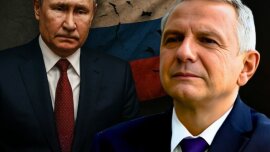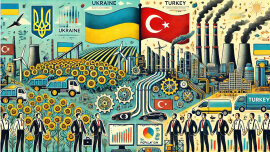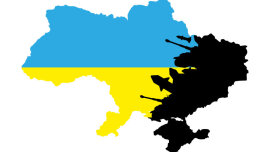At a briefing on January 7, US Secretary of State A. Blinken gave a brief, concentrated and comprehensive description of Russia's actions against Ukraine:
- It was Russia that invaded Ukraine almost eight years ago.
- Russia is the military occupier of Ukraine and Crimea.
- It is Russia that is still fueling the war in eastern Ukraine.
-… Russia is sending troops to the Ukrainian border again.
- All these actions are a violation of Ukraine's sovereignty and a challenge to peace and stability in Europe.
Of course, it would be better if these accurate estimates were made in 2014 during the Obama presidency. For more than seven years, the United States has learned what is happening in and around Ukraine. What can you say about the American explanations of what happened and is happening in Kazakhstan. Of course, no one can simultaneously, online, understand what is happening somewhere far far away. Therefore, A. Blinken was very careful in his statements:
- We really appreciate the relations we have with Kazakhstan.
- We are watching the situation with serious concern.
- we call on everyone to find a peaceful and constructive solution to the situation.
"When it comes to the CSTO, we have questions about the nature of the request, why it arose. We want to know more about this, "Blinken said cautiously, adding:" We certainly call on these PEACEFUL FORCES and law enforcement agencies to adhere to international human rights standards in support of a peaceful settlement. "
What is striking is the use of the term "peacekeeping force" in reference to Russian interventionist forces sent to Kazakhstan. "The United States has no real leverage over Kazakhstan" is the headline in a recent Politico article.
To a large extent, this is true. Because the influence that the United States had on Kazakhstan was tied in one way or another to the pyramid of Nazarbayev's power. And that was a long time ago - in the 90's - in the early 2000's. It was the time of James Giffen, a businessman, the godfather of oil mega-projects in Kazakhstan involving American companies, a longtime adviser to Nazarbayev and "an invaluable source of information for the US government." Kazakhgate put an end to this in 2000s. Although there was no shortage of various advisers from the United States and the United Kingdom, times changed.
But Russia has a real lever of influence over the United States through Kazakhstan. And now it is reinforcing it with the fact of its military intervention under the CSTO flag. The trap that the White House falls into with its Kremlin appeasement policy is called Chevron in Kazakh projects.
Chevron is the second largest American oil and gas company with a market capitalization of $ 164 billion and eighth in the global ranking of energy corporations. It is the largest foreign investor in Kazakhstan. Among other assets, Chevron has major oil projects in Venezuela: 30% in the joint PdVSA with PetroPiar and 39% in PetroBoscan. The company also has 34% of the PetroIndependencia joint venture and 25% of the PetroIndependiente joint venture in the west. Chevron also has 60% of the Laurent natural gas field.
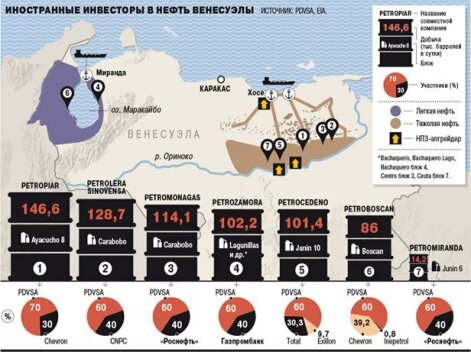
Foreign investors in oil sector in Venezuela
Despite US sanctions against Venezuela and a ban on American companies operating in the country, Chevron is an exception. It maintains a presence in the country with the official permission of the US Administration. This is due to the desire of the company to prevent the assets, in the event of Chevron's exit from Venezuela, going into the hands of Russian and Chinese competitors (see diagram). For its part, Venezuelan authorities have not made any drastic moves against Chevron, while ConocoPhillips and ExxonMobil have been forced to leave the country since the days of Hugo Chavez. At the same time, Chevron is under constant pressure from the Maduro regime, backed by Russia. The threat of nationalization of Chevron's assets in favor of the national PdVSA has forced it to lobby in Washington, starting in 2019, every six months to extend the permit from the Ministry of Finance to work in Venezuela as an exception to the general US sanctions regime against Maduro. In November 2021, the permit was extended again until June 1, 2022.
Another, much more vulnerable part of the American company is its assets in Kazakhstan and Russia - the Tengiz field, the TengizChevroil joint venture (TCO) and the Tengiz-Novorossiysk oil pipeline of the Caspian Pipeline Consortium (CTC), which produces oil for the world market.
For reference:
TCO is a US-Kazakhstan joint venture that has been developing the Tengiz field since 1993. Chevron owns 50%, Kazakhstan's national oil and gas company KazMunayGas - 20%, another US company ExxonMobil - 25%, JV LukArco - 5%. Since 2019, the field produces 30 million tons of oil annually. From 2023, an additional increase in production is expected.
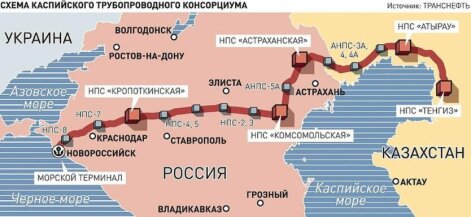
Caspian pipeline consortium
The 1511-km-long CPC pipeline has been transporting extracted TCO oil from Kazakhstan through southern Russia since 2003 and exporting it from the Yuzhnaya Ozereyevka terminal near Novorossiysk. The capacity of the pipeline is 67 million tons of oil per year. The largest shareholders of the CPC are:
- Russia represented by PJSC "Transneft" - 24%,
- JSC NC "KazMunayGas" - 19%,
- Chevron Caspian Pipeline Consortium Company - 15%,
- Caspian Pipeline Company Mobile - 7.5%,
- LUKARCO BV - 12.5%,
- Rosneft-Shell Caspian Ventures Limited - 7.5%,
- CTC Company - 7%.
The CPC pipeline is also used to transport oil from two other giant Kazakh fields, Karachaganak and Kashagan.
The main investors in the CPC were American companies, primarily Chevron, however, the operation of the pipeline was taken over by the Russian oil transportation monopoly Transneft in the 2000s. In practice, Russia, through Transneft, controls the oil flow of American companies from Kazakh fields and, above all, from Chevron's main Asian asset, the Tengiz field, which provides 18% of annual corporate oil production. Its share is growing even more due to the development of another field - Karachaganak, where Chevron has a stake in the consortium for its development - 18%. Another company, ExxonMobil, which is the G1 in the US oil and gas sector, has stakes in both the Tengiz and Kashagan megaprojects.
In connection with the increase in oil production, since 2019 the CPC has launched a bottleneck elimination program (PUVM), which is actually a new project to increase the capacity of the Tengiz - Novorossiysk pipeline from the current level of 67 million tons to 80 million tons per year. The lion's share of investments in PUVM is provided by Chevron, which will receive an additional 12 million tons of oil in both fields - Tengiz and Karachagan - no later than 2023.
In 2020, Chevron sold its stake in the Azerbaijani Azeri-Chirag-Guneshli project and the Baku-Tbilisi-Ceyhan (BTC) oil pipeline. In fact, this step eliminated the CPC's alternative - the use of BTC to export additional volumes of oil on a route independent of Russia. It has been used by TCO in the past, although Chevron claims it was less commercially viable than the CTC. In this way, Chevron increased its dependence on Russia and the Russian oil transportation monopoly Transneft.
Russia immediately took advantage of the increase in Chevron's vulnerability, creating a projection of the threat of restriction on the part of the operator PJSC "Transneft" TCO's access to the CPC pipeline. The first incentive in the history of the CPC to pay dividends in the first quarter of 2021 was a positive "stimulus" for Chevron.
A. Blinken, in his briefing yesterday, aptly remarked, "One lesson of recent history is that once Russians are in your house, it's sometimes very difficult to get them to leave." That's right, but it's not all story. I assume that after the strengthening of Tokayev's power by Russian bayonets, Moscow will move on.
On the one hand, Chevron's leadership has always been on Russia's side, especially after its occupation of Crimea, and has provided invaluable services in promoting its visions and lobbying in the American corridors of power. One example of the company's systematic work is Dialogue Fort Ross, where Chevron, together with Russia's Sovcomflot and Transneft, are long-term sponsors of the Dialogue Fort Ross project. Since 2012, three companies have supported initiatives to preserve and promote the Russian cultural and historical monument in California, as well as promote dialogue between Russia and the United States.
Last year's jubilee 10th Forum on November 2 was attended by Russian Ambassador to the United States A. Antonov, Deputy Foreign Minister Sergei Ryabkov, President of Chevron Neftegaz Inc. E. McGran, known for his pro-Russian views, political scientist from the Kennan Institute M. Rozhansky. The message from the Kremlin to Washington was: "We urge the US administration to change its mind and engage in a serious dialogue with us to nullify existing restrictions and start building up from the ground up, not going down."
Significantly, in 2017, it was the largest US corporations, ExxonMobil and Chevron, which operate in Kazakhstan, that opposed a bill to tighten sanctions on Russia over the risk of halting their oil and gas projects involving Russian companies. And in Kazakhstan, Russian companies are working within the framework of mega-projects of Western companies. Although both companies adhere to the sanctions regime, they strongly oppose attempts to strengthen it based on their corporate interests.
Another scenario that Russia may implement is the squeezing of Chevron and ExxonMobil from Kazakhstan. More precisely, to buy cheap shares of Chevron in TCO and Karachaganak, ExxonMobil - in TCO and Kashagan. It is quite easy to create problems for the Americans with the help of Tokayev's new puppet government. In Nazarbayev's time, this was done more than once because of environmental issues.
In addition, according to Kazakh sources, security companies that provide TCO services in Kazakhstan are full of specialists from Russian private military companies. So it is impossible to rule out the occurrence of a man-made accident with the imposition of colossal penalties on the "culprits", after which they themselves will give up their assets and quietly transfer them as compensation for "damages".
Chevron's vulnerability may have played a role in changing the US administration's approach to Nord Stream-2 in exchange for maintaining Russia's loyalty to Chevron in Venezuela and Kazakhstan. It is noteworthy that last year the same GR-company as Nord Stream-2 - BGR Government Affairs - lobbied Chevron's interests in the corridors of power in Washington. Of course, it was not the only one among the project's lobbyists, but the example is quite illustrative, in the context of how Moscow can wag Washington for Chevron.
Russia's intelligence services may publish a lot of compromising information about the abuse of Americans in Kazakhstan, their corruption in Nazarbayev's time in order to provoke appropriate turbulence and investigations on the banks of the Potomac. The Giffen case mentioned above is just the tip of the iceberg.
Finally, Russia's military presence is not accidental, as it may seem at first glance, appeared in Azerbaijan in 2020, and now in Kazakhstan. Both countries are competitors of Russian oil on the world market, to a lesser extent gas. Therefore, competitors are either taken under control and their income is divided "brotherly" as payment for "protection" services, or destroyed. Is Turkmenistan next?
And Washington will have to make a difficult choice: turn a blind eye to everything Russia is doing in Kazakhstan in the hope that it will preserve the assets of American corporations in the country, or respond to the anti-democratic actions of the new regime of Tokayev and his Kremlin patron.
Author - President of the Center for Global Studies "Strategy XXI"
















